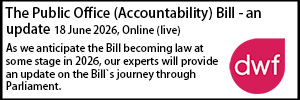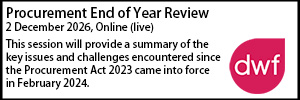Playing the game
- Details
 The NHS recently defeated a legal challenge to a £1bn drugs procurement that included elements of game theory. James Goudie QC analyses the High Court's ruling.
The NHS recently defeated a legal challenge to a £1bn drugs procurement that included elements of game theory. James Goudie QC analyses the High Court's ruling.
The procurement
NHS England sought to procure £1bn worth of treatments for Hepatitis C. It adopted a sophisticated methodology for evaluating bids and awarding contracts, informed by ‘game theory’. A ‘whole market’ approach was taken: even though there are different sub-markets for Hepatitis C drugs (with different types of the disease requiring different treatments, and two out of the three suppliers unable to supply treatments which are suitable for all of the disease types), each bidder was required to submit a single bid for a share of the whole market.
The claimant in AbbVie Limited v NHS England [2019] EWHC 61 (TCC) challenged the following two aspects of the procurement.
(i) A “dummy price mechanism” (“DPM”) was used to assess bids. For evaluation purposes, a bidder was allocated a nominal price for any part of the market which it was unable to treat. This price (the dummy price) was the lowest bid offered by other bidders for that part of the market. Contracts would be awarded for percentage market shares, such shares to be achieved through “rate cards” directing prescribers as to which treatments they should prescribe.
(ii) An unmetered access model (“UAM”) was used, by which each supplier would be awarded, at the end of the procurement, a fixed fee, based on its forecast of the number of treatments it would supply. The fee would not (except in certain situations) vary, regardless of the number of treatments which it subsequently supplied. Clinicians would be free to choose which supplier’s drugs should be used.
The claimant’s challenge
The claimant argued that these aspects of the procurement breached, in particular, the duty of equal treatment in regulation 18(1) of the Public Contracts Regulations 2015.
(i) The claimant argued that the DPM gave an unfair advantage to bidders unable to supply part of the market as compared to those that could. In particular, it argued that the DPM ‘hard-wired’ such an advantage into the procurement: for assessment purposes, a supplier unable to supply part of the market would always be credited with the lowest price offered by its rivals for that part of the market. In the case of one of three bidders, up to 50% of its evaluated price would be made up of the lowest price bid by other bidders in the market segments it could not supply.
(ii) The claimant argued that the UAM was inherently unfair because clinicians were bound to favour its own treatments and those of a second bidder (treatments suitable for multiple genotypes of the disease, without the need for additional treatments) over that of the third bidder (whose treatment cannot treat all genotypes). The result, said the claimant, was that a supplier with better drugs would end up supplying more treatments than the nominal forecast underlying its fixed fee (so-called ‘unremunerated supply’); and the supplier with the less effective treatment would end up supplying fewer treatments than the nominal forecast underlying its fixed fee.
General principles: equal treatment and the margin of discretion
Choudhury J, dismissing the claim, gave important guidance on contracting authorities’ ‘margin of discretion’ in the context of their duty of equal treatment, setting out the following principles.
(i) The question of whether the equal treatment principle has been breached must be considered in context, having regard to the general purpose of ensuring the development of effective competition (§48).
(ii) Contracting authorities are afforded a wide margin of discretion in designing and setting award criteria (§53).
(iii) A contracting authority does not necessarily breach the equal treatment principle simply by selecting a scoring system which could favour one bidder as compared with an alternative scoring system (§57).
(iv) The judge rejected the claimants’ argument (citing Woods Building Services v Milton Keynes Council [2015] EWHC 2011 (TCC), Energy Solutions EU Ltd v Nuclear Decommissioning Authority [2016] EWHC 3326 (TCC) and MLS (Overseas) Ltd v Secretary of State for Defence [2017] EWHC 3389 (TCC)) that the question of whether there has been a breach of the equal treatment duty is a “hard-edged question in respect of which a contracting authority is not to be afforded any margin of appreciation”. The judge held that the position is more nuanced than this. The authority will have a margin of discretion at the first stage of the equal treatment analysis, that is, in determining whether there is unequal treatment of like cases, or similar treatment of un-like cases. If that were not the case then any difference in treatment would need to be objectively justified, regardless of context, scale or purpose. That could not be correct (§§62, 65-66). However, the authority would have no margin of discretion at the justification stage, if the claimant succeeded in establishing that there was unequal treatment which fell to be justified.
The dummy price mechanism
The judge rejected the challenge to the DPM for the following reasons.
First, it did not involve unequal treatment of bidders in a comparable situation. The equal treatment principle requires that comparable situations must not be treated differently and that different situations must not be treated in the same way (unless such treatment is objectively justified): Cases C-21/03, C-34/03 Fabricom v Belgium [2005] ECR I-01559. In this case, bidders were treated differently: one bidder was allocated a dummy price, and another was not. But two such bidders were not in a comparable situation: one of them had drugs capable of treating the whole market, whereas the other did not. The situation was analogous to one where a contracting authority treats an incumbent differently from its competitors, in order to try to level the playing the field (see e.g. Case T-211/17 Amplexor Luxembourg Sarl v European Commission). Since the DPM entailed differential treatment of bidders in relevantly different situations, it did not breach the equal treatment principle (§§76 – 78).
Further, the alleged ‘hard-wiring’ of an advantage for bidders who could not serve the whole market did not disclose unequal treatment: the purpose of the DPM was simply to enable the like-for-like comparison of bids’ value across the whole market; it would not entail a supplier being given a market share which it was unable to serve; and it did not prevent any bidder from winning the largest market share available in the procurement (§85).
The exercise of comparing the level of market share which the claimant was likely to achieve using the DPM with what it might achieve under an alternative approach did not greatly advance its case on unequal treatment. The fact that a bidder might fare better than a rival under a particular model did not necessarily mean that the model entailed a breach of the equal treatment principle (§§90 – 93).
In short, the choice of model in this case fell within the wide discretion available to contracting authorities to choose award criteria which suited their purposes.
Secondly, even if the DPM did involve unequal treatment, it was justified. It was designed to facilitate competition between suppliers across the whole market, where suppliers would otherwise enjoy a monopoly or duopoly over certain segments of the market. As such, it increased competition. In those circumstances, it was a proportionate means of pursuing NHS England’s legitimate aims, namely: increasing competition; thereby achieving greater value (lower prices and better treatment initiatives) from bids; and thereby maximising the health benefits from the procurement.
The ‘fixed fees’ under the unmetered access model
The challenge to the use of ‘fixed fees’ under the UAM was also rejected by the judge.
The judge held that there was no unequal treatment because all suppliers were, for this purpose, in a comparable position and subject to the same rules. A difference of popularity in the treatments offered by two competitors did not mean that the two were not comparable for the purposes of a tendering exercise. The application of the same tender rules to all suppliers, irrespective of competitive position, did not amount to unequal treatment (§§155 – 156).
In any event, even if there had been a breach of the equal treatment principle, any discriminatory effect would be modest and thus relatively easy to justify; and the fixed fees were justified as a proportionate means of achieving the legitimate aim of encouraging suppliers to make greater investments in treatment initiatives, by providing them with greater assurance that their revenues would be stable (§178).
James Goudie QC is a barrister at 11KBW.
Jason Coppel QC and Joseph Barrett of 11KBW (instructed by CMS Cameron McKenna Nabarro Olswang LLP) acted for the claimant.
Patrick Halliday of 11KBW (instructed by Blake Morgan LLP) acted for the defendant.
Sponsored articles
Walker Morris supports Tower Hamlets Council in first known Remediation Contribution Order application issued by local authority
Unlocking legal talent
Senior Lawyer - Planning, Property & Contracts Team
Legal Director - Government and Public Sector
Principal Lawyer - Planning, Property & Contract
Locums
Poll
15-07-2026 11:00 am








































